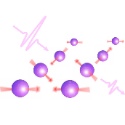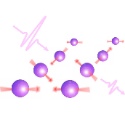Electrically driven spin excitations
Multiferroics contain two or more ordered phases—such as ferromagnetism and ferroelecticity. In perovskite multiferroics—typically of the form , where , and —it is possible to control the ferroelectric polarization using magnetic fields (and the magnetism using electric fields), a feature that is likely to make these materials important for applications in spintronics and data storage. This magnetoelectric response is strongest in , in which a magnetic field can increase the dielectric constant fivefold and even flip the ferroelectric polarization by 90 degrees. This high sensitivity is believed to be due to the unique spiral magnetic order that coexists with ferroelectricity in these materials.
Conventional ferroelectricity emerges because the ions in the crystal lattice displace (another way to say this is that the optical phonons condense). What are the collective modes responsible for magnetically driven ferroelectricity in materials like ? Recent theoretical proposals have claimed they are “electromagnons”—rotational modes of the spiral spin structure that can be electrically activated. Noriaki Kida and colleagues at the University of Tokyo and Tohoku University report a study of these modes in Physical Review B. Using terahertz time domain spectroscopy they obtain the complete optical spectra for single crystals of by varying the light polarization, temperature, and magnetic field. The authors identify an electromagnon excitation in the optical absorption band, but find that it cannot be the collective mode driving ferroelectricity because it survives irrespective of the direction in which the spins spiral. These findings contradict existing theoretical proposals and call for new ideas. – Sarma Kancharla





